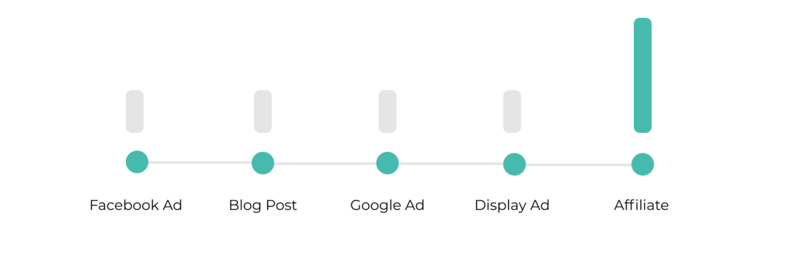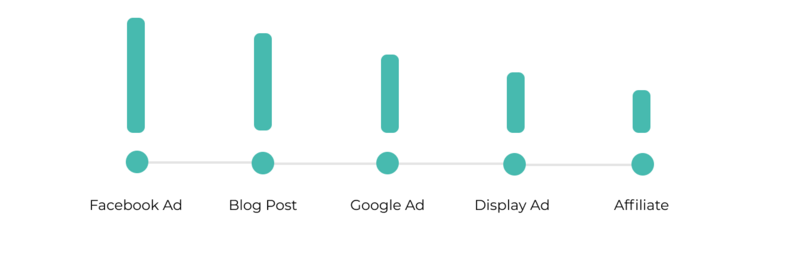Marketing Attribution
What is marketing attribution and why is it important?
It’s one of the most asked, if not the most asked question in modern digital marketing. What is marketing attribution exactly? To keep it really simple, it’s something that you’re already doing on a daily basis.
Whenever you are analyzing the performance of your marketing activities you apply marketing attribution. Because that’s the moment where you attribute a certain amount of revenue to a channel, source, campaign, ad group or keyword.
This is crucial for marketing teams to be able to understand customers behavior in their paths to purchase, and allows them to adjust their marketing mix to be more efficient.
At Odyssey, our definition of marketing attribution is:
“Marketing Attribution is the process of analyzing your data in order to give credit to the touchpoints in a customer journey, enabling you to identify the incremental performance of every traffic source based on its role in the customer journey. This analysis should result in actionable insights that help you to spend your marketing budget as efficiently as possible.”
In Google Analytics, the acquisition report is already a way of doing attribution. It’s far from perfect as it’s based on last-non direct click, but we’ll talk more about that later.
Why Marketing Attribution is needed
Marketing Attribution has been a complex issue for as long as digital marketing has been around. Ever since marketers are using ads and sponsorships to influence people, questions about the performance of the different media activities are asked.
At this moment, the industry’s standard is last-click attribution. Meaning only the last click in the customer journey is being credited. In Google Analytics, the standard attribution model is last non-direct click.
Both of these attribution models are commonly known and used, but they are also both single-touch attribution models. With multi-touch attribution, every touchpoint in the customer journey is being credited.
The big advantage of multi-touch attribution over single-touch based attribution is that both touchpoints that are starting customer journeys (TOFU) and touchpoints that are closing journeys (BOFU) can be credited for their added value.
Every touchpoint in the customer journey is being credited for its performance in the customer journey. Click here to read an article our co-founder and CEO Jelle Oskam wrote on how a customer journey is similar to a football team.
The goal of marketing attribution
The goal of applying marketing attribution is simply to get a better view of the performance of the different marketing channels. Applying marketing attribution makes marketers understand the path to conversion and the role of the different attribution models in that journey.
Thanks to these additional insights into the full customer journey, companies can optimize the marketing campaigns and ad spend distribution over different marketing channels and look at their marketing spend as a whole instead of in silos.
In general, marketing attribution provides a great insight for marketeers, allowing for the analysis of all channels and marketing touchpoints, and thus a better lead generation.
An example
In order to understand marketing attribution. We are using an example of one single customer journey. Below you can find an example:

In the example above you see an example customer journey for the purchase of a pair of new sneakers. This customer journey consists of five touchpoints before the customer purchases the product. When applying last-click attribution, only the last click (Affiliate in this case) is being rewarded for the purchase of the new sneakers.

So let’s take a look at the same customer journey with a multi-touch marketing attribution model. When applying multi-touch attribution we are crediting all of the touchpoints for their value in the customer journey.
The way that’s being done is based on the selected attribution model. In this example we are looking at a first click linear attribution model, meaning that the first click will be rewarded most (this time an ad on social media), and the added value of the other channels is being reduced linearly, depending on the position of the touchpoint.

As you can see, all touchpoints are being rewarded, but the credit each touchpoint receives depends on the position. This way, we get a far more ‘fair’ image of the performance of the different touchpoints in the customer journey.
Marketing Attribution Models
Inherently linked to marketing attribution are attribution models. Attribution models are basically the formulas used to divide the value the touchpoints bring in the customer journey.
There are many different attribution models, the most important thing to know is that there is no one size fits all. Each organization should seek to discover which attribution model fits best to their business and customers. This could even vary in different time periods, for example when running a sale campaign.
On the highest level we can make a distinction between single-touch and multi-touch attribution models. Single-touch attribution models only credit one touchpoint in the journey, where multi-touch attribution credits multiple touchpoints in the customer journey.
Below you can find an image of some of the most used attribution models. These range from first click and last click models (single touch) to models that put equal weight to each touchpoint (linear) or models that value certain clicks more than others, such as first/last click linear or time decay.

Marketing Attribution in Google Analytics
As mentioned in the beginning, whenever you’re looking at the performance of a traffic source in Google Analytics, you are looking at attribution data.
Let us start by saying that Google has outstanding tracking software and Google Analytics is, without doubt, an excellent free tool that has made web analytics available to the masses. We even recommend using Google to track your data. However, there is an important difference between collecting and interpreting data.
There are two vital downsides to relying on Google for the interpretation of your data (i.e. for attribution purposes).
The most crucial issue; Google isn’t an independent player. At the very least, it will be optimized to favor its own products such as Google Ads which is one of their cash cows.
As an independent tool, marketing attribution tools like Odyssey Attribution have no incentive to mask data or safeguard any parties. Unbiased data will be presented to you as it is and all calculations are based on a complete picture.
Secondly, Google Analytics doesn’t allow a connection with any cost data sources except their own. A complete integration of cost data is very useful in attribution and even vital to make strategic business decisions.
Odyssey imports cost data from tools such as Google Ads, Facebook, Instagram, Awin and Impact Radius. This allows users to see valuable and actionable insights such as the difference between their current media spend and a suggested media spend.
Want to learn more about attribution in Google Analytics? Check out our free whitepaper.
Learn more about us
In case you want to find out more about digital marketing or attribution, make sure to check out our blog or our other academy posts. You can also schedule a demo and start experiencing it for yourself!
